| Andreas Weiland
THREE INSTALLATIONS BY LEEN LYBEER
1 - An installation evocative of time passing ?
I have recently seen a surprising work of art. It's a
circle, parted by its diameter in the middle, constructed perhaps in a
way that is a bit complicated. For this is not an abstract circle; it is
a circle made of sand or some such material that is very fragile, very
uneven, very fascinating and rich in its complexity. It's a sort of
cake, the way children make it, attached to a load-bearing support, perhaps
made of glass, which is also round and a bit elevated: between earth and
sky (or the ceiling), thanks to a supportive pillar made of the same material.
A constructive idea which takes considerable courage.
As one sees, this entire construction incorporates an
opposition: There is the technologically modern support which is clear,
constructivist, abstract. And the cake, made of sand. Which seems
mystic, like the Greek ómphalos, the umbilicus, archetypal image
of all ORIGIN. And which, simultaneously, appears like a mixture of the
abstract (the circular, the abstract form of the circle!) and the irregular,
almost organic (a quality of sand).
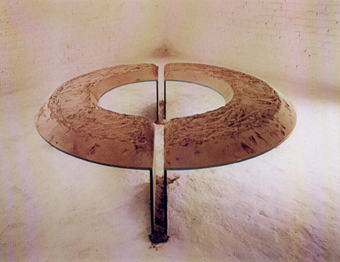 installation
by Leen Lybeer installation
by Leen Lybeer
This strange object has been (dis-)placed into an irritating
situation: it is surrounded by a brick wall, its archaic appearance -
while the floor of this place is probably covered by sand, as well. What
does it mean? For me, the evocation of the image of an excavation site
is very present. The installation is charged with energy because of its
montage of opposite elements: the ancient, represented by the impression
that one is seeing an ancient location that has been excavated - and the
modern, suggested by the clear and rational support made of glass. And
given with this support, placed on this very structure, there is the thing
made of sand - simulation of an exhibited objet trouvé, which is
certainly breathing an archaic spirit.
The irritation caused is considerable; the past is present;
but modernity is also present. This very modern work of art, this installation
has integrated an element that is ancient or that is about to turn ancient,
a fragile moment (to put it differently) which, by its tenderness and vulnerability,
must evoke the consciousness, the realization of the awareness that
everything modern must turn ancient, in another time, in our future.
2 - Tennis Court Art. Another installation by Leen
Lybeer
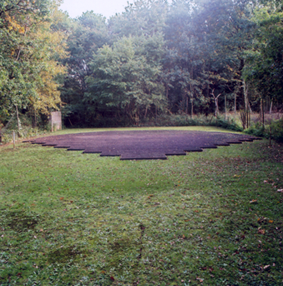 click to see
larger image
click to see
larger image
The old tennis court
site, transformed into
land art. An installation
by Leen Lybeer
This is a mystic form, a magical form which I have discovered
in the midst of a strange nature, a sort of virginal forest where a small
clearing is visible. Much of this clearing seems to be blue almost, it
is of a blue verging on lilac, and the contrast with the green of the surrounding
trees, a dark green, and the other green which is a light one, is of great
beauty. The blue form appears as a contrast in another sense, too.
It is abstract and, on first sight, because of its homogenous color,
it appears like a man-made substance: artificial and, by consequence, not
organic like the trees or a clearance. It is limited by a metal band that
is a bit shiny, which accentuates the impression of seeing a non-organic
object. But all this is only a first impression. An impression which
certainly incorporates a moment of truth but which ignores the process
of constructing this installation, its history which is also the history
of its site. And it ignores the concept, the thoughts of the artist, her
goal, her intention that may have been pre-consciously present, perhaps.
If I have been able to view this ensemble a bit like a situation that is
comparable to that of a temple inserted into the rain forest of Guatemala,
a temple abandoned today, a temple left alone by itself, without men and
women, without being used, practically abandoned to the wind and the rain,
this is a description of an emotion caused by this work of art. But, on
the other hand, the facts are clear: As starting point, we have nothing
but a tennis court, the site of a tennis court abandoned to nature. This
human creation, inserted into a space covered by trees as a rectangular
place, and insofar abstract, but changed by time and nature which have
given to this site a cover of green grass, is also changing our "reading"
of the art work that has been incorporated right here. A work, made
of peat (that is colored?, at any rate, ephemeral) and of metal,
that is in some way derived from a definitive form used earlier on by the
artist in another context. It is the form of an architectural model,
a maquette of the semicircles of seats in a modern or ancient theater,
and it appears like a design reduced to its extremely abstract essence.
Putting it differently, one may say that it is the abstract (the form of
this maquette) inserted into something abstract which has turned more organic,
more like nature (the rectangular tennis court, transformed by time, the
wind, etc.).
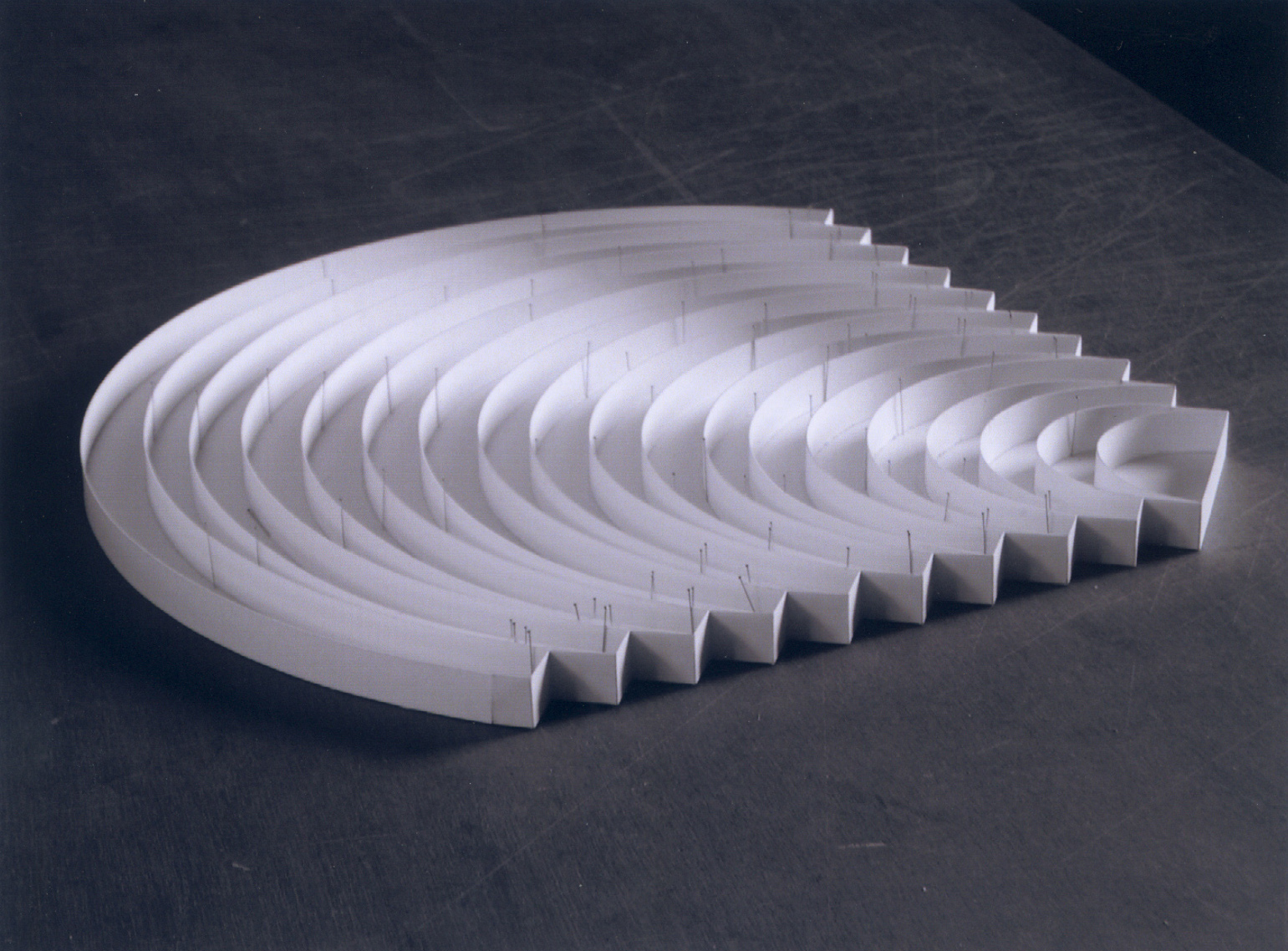 the maquette the maquette
And this form of abstract or conceptual art inserted here
is also going to change, sooner or later, in the same direction.
This abstract form, derived from the modern theater, derived from ancient
theater, is, in the last analysis, more than a mystic form, more than a
universal form which appears like a tree leaf made simple that has changing
meanings, in history and in different cultures. Derived, logically and
consciously, from the ancient form of the Greek theater (the amphithéatron
), it has incorporated the logic of constructing this type of theater -
a theater of the kind which I have seen in Delphi, inserted plausibly in
the sloping nature of the hills, as architecture organically adapted to
the topography. In other words, the fact is decisive that the derivation
of the constructivist form of the blue and mystic "icon" has been
obscured in the history of the process of its construction. The mystery
is nothing but the forgotten praxis [practice] of human ingenuity; it is
the forgotten fact that the abstract, clear, constructivist thought of
the architects and the artists is derived from the act of observing (organic)
nature; it is the forgotten fact that the respect for the function (of
the theater, in this case), the respect for the needs of people (the Greek
men and women, in this case, which made use of their theater, inserted
into the hills) was at the origin of a form that turned abstract.
The mystification, the mystic or magic impression of the object results
from the fact that one has forgotten the origine, that a caesura exists,
an isolation from the past and a concentration on the moment. Its presence.
It is true, there exists also - within the ensemble of this
installation composed of a nature exposed to the dual insertion of a tennis
court and an esthetic form - this anticipation of the future, departing
from a presence which knows the anticipation of finiteness. But nothing
beyond this. In this moment of a look embodying all one's concentration
which aids the isolation of the things perceived, the impression of a fascinating
combination, the montage of a mythic object with an irritating nature can
result. It is the reflection of the production process of a work of art
and of its historical preconditions which dissipates the myth in a certain
way. But not without "enriching" our esthetic experience by making our
perception of the work of art richer and more complex. And this, certainly,
without responding, in any way, to all of its questions, to all of its
potentiality.
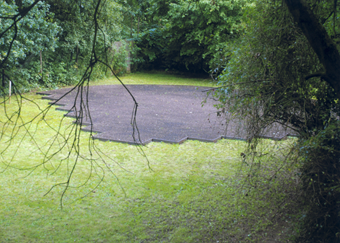 click to see
larger image
click to see
larger image
changing land art
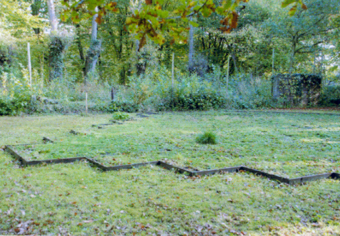 click to see larger
image
click to see larger
image
...and still changing ( - there exists an even larger
documentation of these changes...)
*
*
*
3 - The installation exhibited in Bratislava by
Leen Lybeer
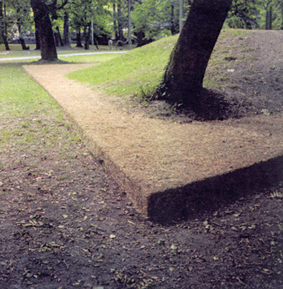 the installation
in Bratislava... by Leen Lybeer the installation
in Bratislava... by Leen Lybeer
In Bratislava, Lenn Lybeer created another installation
that is also integrated into nature. This installation is using a
natural material, as well - straw. A square or rectangular space
has been formed by straw around the green grass growing below a tree. The
edge of the space covered by grass is not straight but runs in irregular
fashion. The limit of the added space is abstract, clear and regular. This
work amounts to an act of montage and also an act of confrontation of culture
and nature, of a form made or produced by the artist with a form spontaneously
produced by nature. The boundary where the two spaces meet
is of considerable interest. It is the meeting point, the line
of osmosis between the man-made and the other which escapes, to some extent,
the control of man if he is prepared to let nature pursue its course. But
this is not all. Another force is going to intervene, the force of
time, the forces of the wind, the rain. Without the repeated intervention
of man, the artificial and abstract addition (made of a material as transitory
as straw) is determined to change its character; its destiny is no other
destiny than that of a metamorphosis. Which will transform the entire ensemble,
all of the installation, by an indeterminate or random process, into
a bit of nature.
© Copyright of all images by Leen Lybeer.
|